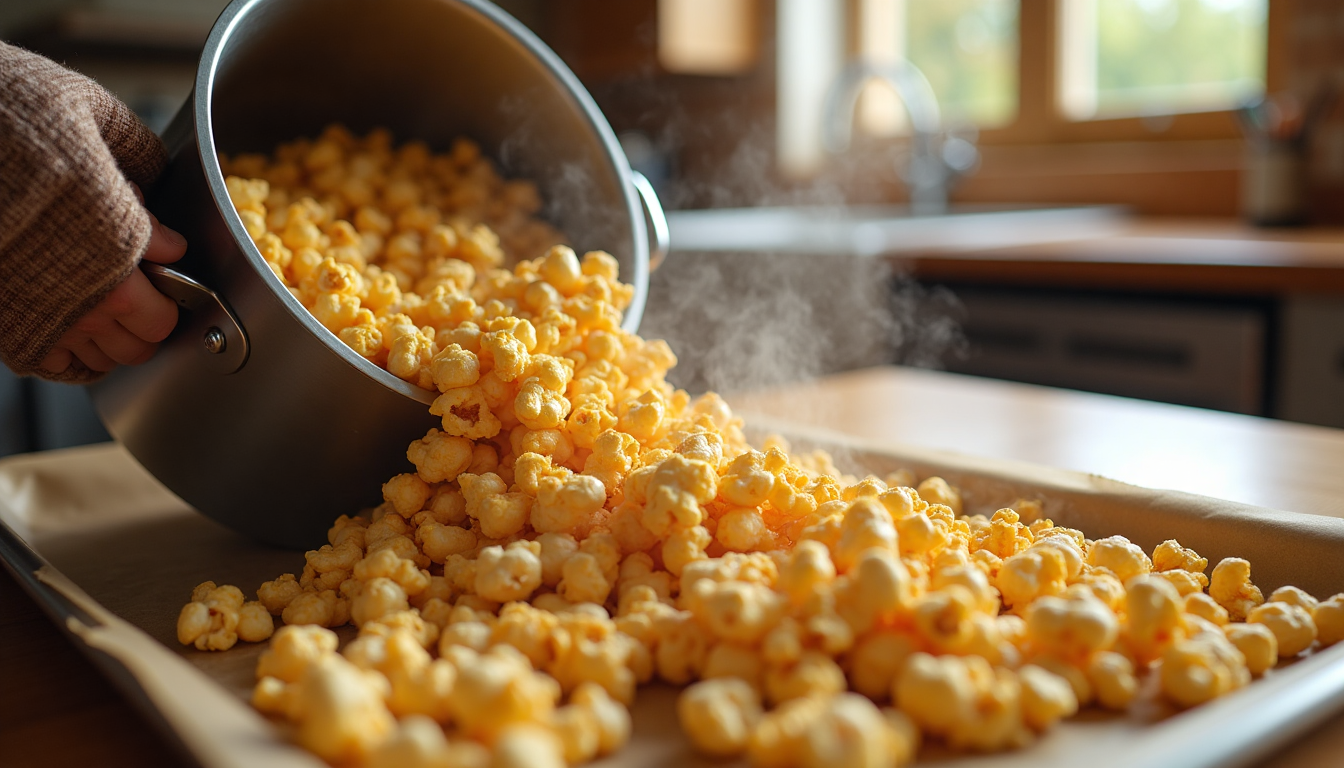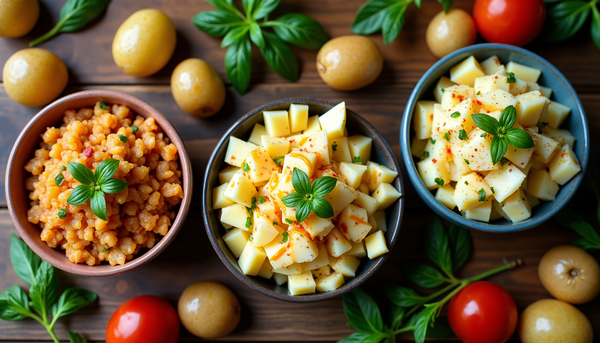Stop Buying Kettle Corn (Seriously, Just Stop)

Look, I need to tell you something that's gonna sound absolutely ridiculous coming from someone who once spent three hours making "artisanal" ice cubes for a cocktail party...
Making kettle corn at home is so stupidly easy that I'm genuinely embarrassed I didn't figure this out sooner.
Like, we're talking about a snack that costs $6 for a tiny bag at the farmers market. A snack that disappears in approximately 3.7 minutes and leaves you staring at the empty container wondering if you have a problem. (Spoiler: you don't have a problem. Kettle corn is just that good.)
But here's what I discovered after months of what I'm generously calling "research" (aka stress-eating my way through this recipe): homemade kettle corn isn't just cheaper or more convenient. It's actually better. And I'm about to tell you exactly why, plus how to nail it every single time.
The Great Kettle Corn Awakening
So picture this: I'm standing in my kitchen at 9 PM on a Tuesday, wearing mismatched socks and having one of those "I want something but I don't know what" moments. You know the ones. Where you open the fridge seventeen times hoping something new will materialize?
I was craving that perfect sweet-salty crunch that only kettle corn delivers. But the closest place that sells decent kettle corn closes at 8, and honestly? I wasn't about to put on real pants just for a snack run.
That's when I remembered seeing a bag of popcorn kernels shoved in the back of my pantry. And then it hit me - what if I could just... make it myself?
Thirty minutes later, I was sitting on my kitchen floor with a bowl bigger than my head, covered in sugar crystals, wondering why I'd been spending money on inferior kettle corn for years.
Why Store-Bought Kettle Corn Is Playing You
Okay, let's be real about what you're getting when you buy kettle corn:
The Good Stuff (Rare): Fresh, perfectly balanced sweet-salty magic that makes you question all your life choices up to that point.
The Usual Stuff: Stale-ish kernels with uneven coating that's either too sweet, too salty, or somehow manages to be both while tasting like cardboard.
The Tragic Stuff: That pre-bagged nightmare from the grocery store that tastes like it was made sometime during the Clinton administration.
Here's what nobody tells you about commercial kettle corn: most of it sits around for weeks. Even the "fresh" stuff from fancy places? It's probably been sitting in a container for at least a few days, slowly losing that crispy perfection.
When you make it at home, you get to eat it while it's still technically cooling. Which is... chef's kiss... an entirely different experience.
The Four-Ingredient Revolution
This is where things get stupidly simple. You need exactly four things:
- Popcorn kernels (please, for the love of all that's holy, check the expiration date)
- Oil (I'll fight anyone who says coconut oil isn't the move here)
- Sugar (and here's where it gets interesting...)
- Salt
That's it. That's the whole list.
But here's where I'm gonna get a little nerdy on you, because after burning through approximately 47 batches trying to perfect this, I've got opinions.
The Sugar Situation
Everyone's out here using regular white sugar like it's 1987. But turbinado sugar? That's where the magic happens. It's got this subtle molasses flavor that makes your kettle corn taste like it came from some artisanal county fair instead of your chaotic Tuesday night kitchen.
Is it necessary? No. Will it make you feel like a culinary genius? Absolutely.
The Oil Drama
I've tried everything. Vegetable oil, canola oil, avocado oil, olive oil (terrible idea, don't do this), and finally landed on refined coconut oil.
Why coconut oil? Because it has a high smoke point, neutral flavor, and something about the way it coats the kernels just works. Plus, when it cools, it gives the kettle corn this subtle richness that makes store-bought versions taste flat.
Unrefined coconut oil works too, but you'll get a hint of coconut flavor. Which honestly... isn't the worst thing in the world.
The Technique (Or: How to Not Burn Sugar at 9 PM)
Here's where most people mess up kettle corn, and where most recipes fail you: they make it sound way more complicated than it actually is.
The Real Method:
Step 1: Line a baking sheet with parchment paper. Trust me on this. Hot sugary popcorn and kitchen counters don't mix.
Step 2: Get a heavy-bottomed pot - like, a 3-quart saucepan. Add your oil and exactly 3-4 test kernels. Cover it.
Step 3: Heat on medium-high until those test kernels pop. This is your signal that the oil is ready.
Step 4: Add the rest of your kernels and shake to coat. Sprinkle the sugar and salt over everything, cover, and shake again.
Now here's the part where you become a human maraca...
Step 5: Keep that pot moving. Every 5 seconds, give it a good shake. This prevents burning and makes sure the unpopped kernels stay on the bottom where the heat is.
Step 6: When the popping slows down to about one pop every 2 seconds, you're done. Remove from heat immediately.
Step 7: Dump everything onto your prepared baking sheet and spread it out. Use a wooden spoon to break up clumps.
The Shake Game
Look, this isn't a gentle "swirl the wine" situation. You need to shake this pot like you're trying to wake up everyone in your building. Hold the lid down with one hand (oven mitt recommended unless you enjoy pain), grab the handle with the other, and go to town.
Your neighbors might think you've lost it. Your arm might get tired. But your kettle corn will be evenly coated and perfectly cooked.
When Things Go Wrong (A Personal History)
Let me share some of my greatest hits in the "learning experience" category:
The Great Burn of October 2023: Thought I could multitask and answer emails while making kettle corn. Ended up with what I generously called "rustic caramelized popcorn" but was actually just burnt kernels covered in bitter sugar.
The Under-seasoned Incident: Got distracted and forgot to add salt. Made a whole batch of sweet popcorn that tasted like disappointment with a college dorm room aesthetic.
The Sugar Volcano: Used too high heat and created what can only be described as a sugary crime scene in my kitchen. Took three days to clean properly.
But here's the thing about mistakes - they teach you exactly what works. Medium heat, constant attention, and timing are your friends. Multitasking and impatience are not.
Level Up Your Game
Once you've mastered basic kettle corn (and you will, probably on your first try because it's honestly not that hard), you can start getting creative.
Flavor Adventures I Actually Recommend:
Cinnamon Sugar Situation: Add a pinch of cinnamon to your sugar mix. Tastes like fall in a bowl.
Everything Bagel Chaos: Sprinkle everything bagel seasoning on while it's still hot. Sounds weird, tastes incredible.
Parmesan Madness: Grate fresh Parmesan over the hot popcorn. Sweet, salty, umami perfection.
Chocolate Drizzle Drama: Melt some dark chocolate and drizzle over cooled kettle corn. This is dangerous territory.
Flavor Adventures I Do NOT Recommend:
Hot Sauce: Just... no. The sugar and heat don't play well together.
Herbs: Tried rosemary once. Tasted like I was eating a Christmas tree.
Too Much Salt: There's a fine line between "perfectly seasoned" and "Dead Sea recreation."
The Storage Reality
Homemade kettle corn is best eaten immediately. Like, still-warm-from-the-pan immediately.
But if you somehow have leftovers (who are you and how is your willpower so strong?), store it in an airtight container. It'll stay decent for about a week, but the texture is never quite the same after the first day.
Pro tip: make smaller batches more often rather than trying to meal prep kettle corn. Future you will thank present you for the restraint.
The Cost Breakdown That'll Make You Mad
Ready for some math that'll ruin store-bought kettle corn for you forever?
- Popcorn kernels: about $0.30 per batch
- Oil: about $0.15 per batch
- Sugar: about $0.10 per batch
- Salt: basically free
Total cost per batch: less than $0.60
That same amount of kettle corn at the store? Minimum $4, often more.
You're literally paying 600% markup for the privilege of eating stale popcorn. I'm still processing this information and it's been months.
Why This Actually Matters
Look, in the grand scheme of life problems, overpriced kettle corn ranks pretty low. But here's what I've realized through this whole obsessive journey:
There's something incredibly satisfying about taking back control of the stuff you eat regularly. About realizing that the "complicated" thing you've been buying is actually stupidly simple to make at home.
It's not just about the money (though that's nice). It's about that moment when you taste your first batch and realize it's better than anything you've bought. It's about being able to make exactly the amount you want, exactly when you want it.
And honestly? It's about feeling a little bit like a kitchen wizard when your friends try it and immediately demand the recipe.
Your Turn to Join the Revolution
So here's my challenge to you: next time you're craving kettle corn, don't reach for your car keys. Reach for a pot.
Give yourself 15 minutes and four ingredients. See what happens.
And when you inevitably eat the entire batch while standing in your kitchen at 10 PM, wearing pajamas and questioning your life choices... welcome to the club. We meet never, because we're all too busy making more kettle corn.
Have you tried making kettle corn at home? Any epic failures or surprising successes? Drop a comment and let me know - I'm always looking for new ways to perfect this completely imperfect process.
Now if you'll excuse me, I can hear my pot calling...




